Hot Projects
OriginTrail Decentralized Knowledge Graph for trusted cross-organi… | EVM News


Trace Labs, the core developers of OriginTrail, has joined the European Union’s initiative to foster a resilient and adaptive manufacturing ecosystem through the DMaaST project. Collaborating with partners from Slovenia, Spain, Germany, Portugal, Turkey, Serbia, Belgium, Lithuania, France, Denmark, and Switzerland, the initiative will leverage the OriginTrail Decentralized Knowledge Graph (DKG) and Knowledge Assets (KA) to encapsulate all pertinent information regarding products, processes, facilities, and human expertise. This comprehensive approach will facilitate the precise mapping of data flows and knowledge interconnections, laying the groundwork for comprehensive information mapping within the manufacturing ecosystem using OriginTrail DKG. Consequently, this will ensure trustworthy cross-organizational real-time data integration.
Once more, attention has been drawn to challenges within the aeronautic and manufacturing industries following a January incident in which a Boeing 737 MAX 9 door plug blew out in the middle of an Alaska Airlines flight. If the company had established reliable cross-organizational communication, it could have prevented this incident. Such communication would enhance the value chain’s responsiveness to external and unforeseen events, as well as improve operability and production planning capacity.
Effective, transparent, and reliable data exchange are the most important points for fostering sustainability, resilience, and energy efficiency in the manufacturing industry. However, over the past years, various challenges have come to the forefront within this sector.
-
Supply Chain Disruptions: The COVID-19 pandemic highlighted existing vulnerabilities in global supply chains, leading to disruptions in the flow of materials and components. Issues such as raw material shortages, transportation bottlenecks, and labor shortages have persisted, impacting manufacturing operations worldwide.
-
Cybersecurity Risks: With the increasing digitization of manufacturing processes through technologies like the Internet of Things (IoT) and Industry 4.0, cybersecurity threats have become a significant concern. Manufacturing facilities are increasingly vulnerable to cyberattacks that can disrupt operations, steal sensitive data, or compromise product quality and safety.
-
Data Silos: Manufacturing organizations often operate with fragmented data systems, leading to isolated data silos across departments or functions. This fragmentation inhibits seamless data interoperability and hampers comprehensive insights that could drive operational efficiency and innovation.
-
Lack of Standards: The absence of standardized data formats and protocols complicates data exchange and integration efforts within and across manufacturing enterprises. Without universally accepted standards, interoperability becomes a significant challenge, impeding the flow of data between different systems and stakeholders.
-
Data Privacy Concerns: With the proliferation of data collection and sharing practices in manufacturing, ensuring data privacy and protection is paramount. Manufacturers must navigate complex regulatory landscapes, safeguarding sensitive information from unauthorized access or misuse while balancing the need for data-driven decision-making.
-
Ownership and Control: Determining ownership rights and control over manufacturing data can be contentious, especially in collaborative environments or supply chain networks. Disputes may arise regarding data ownership, usage rights, and intellectual property, complicating data sharing agreements and hindering collaborative initiatives.
-
Legacy Systems Integration: Many manufacturing facilities still rely on legacy systems that were not designed with interoperability in mind. Integrating these outdated systems with modern data platforms and technologies poses significant challenges, requiring extensive customization, retrofitting, and investments in interoperability solutions.
DMaaST aims to enhance manufacturing ecosystem resilience and adaptability by employing a Smart Manufacturing Platform comprising four layers. The data layer establishes a foundation for real-time data integration across organizations using ontologies and OriginTrail Decentralized Knowledge Graph. Following this, a two-level cognitive digital twin is deployed to model both manufacturing services production lines and value chain stages. It incorporates human expertise, data-driven algorithms, and physical modeling. An algorithm for multi-objective distributed decision support systems leverages this data to facilitate optimal production decisions. Outcomes will be communicated via user-friendly interfaces and timely scoreboards, assessing circularity, sustainability, and product traceability. Over the four-year period, DMaaST ensures scalability and innovation by providing insights for replicating and improving manufacturing processes, advancing technologies in aerospace and electronics sectors.
Trace Labs will lead the data working group to develop and validate technologies aimed at facilitating data understanding, interoperability, and secure cross-organization integration. With integration of OriginTrail DKG for the electronic and aeronautical sector, creating a new powerful knowledge base with artificial intelligence capabilities. The DKG will establish a decentralized database accessible to all participants in a manufacturing value chain, including manufacturers, suppliers, distributors, retailers, regulatory bodies, research institutes, and others. This will enhance the manufacturing ecosystem’s ability to autonomously withstand and adapt to external events.
OriginTrail DKG has been widely utilized to foster trust and transparency in enterprise knowledge exchange across various industries. Now, it is evolving to facilitate global knowledge connectivity, powering the Decentralized Retrieval Augmented Generation (dRAG) framework for more precise and inclusive AI. Given the challenges of verifying AI-generated results, OriginTrail DKG, with Knowledge Assets as its primary resource, represents a pivotal innovation in this context. It offers a robust framework for ensuring the ownership, discoverability, and verifiability of information utilized by AI systems for the manufacturing industry.
Project information available here: DMaaST Project
Hot Projects
Hamster Kombat Reaches 239M Users in 81 Days | EVM News


YEREVAN (CoinChapter.com) — Telegram founder Pavel Durov announced that Hamster Kombat has reached 239 million users in just 81 days.
Hamster Kombat’s viral success has been phenomenal. Since its launch in March 2024, the game has attracted over 200 million players. Durov highlighted some impressive metrics, including the game reaching 100 million monthly users in just 73 days. The game continues to grow, adding 4-5 million new users daily. This makes it one of the fastest-growing digital services globally.
Durov shared these insights on his Telegram channel, which has 2.7 million subscribers. He emphasized that the game’s popularity could introduce many people to Web3 and blockchain technology.
Hamster Kombat Prepares for Token Launch on TON Blockchain in July 2024
Hamster Kombat’s upcoming token launch on the TON blockchain is highly anticipated. The project’s roadmap shows that on-chain infrastructure and in-game wallet implementation were completed in June 2024. Players have been able to link their TON wallets in the game since June.
Durov mentioned that the token minting would happen soon. He stated,
“Soon, Hamster’s team will mint its token on TON, introducing the benefits of blockchain to hundreds of millions of people.”
The official website suggests that in-game token utility will roll out in July 2024. The exact date for the token launch has yet to be confirmed. However, the developers have been preparing the community through frequent updates on social media.
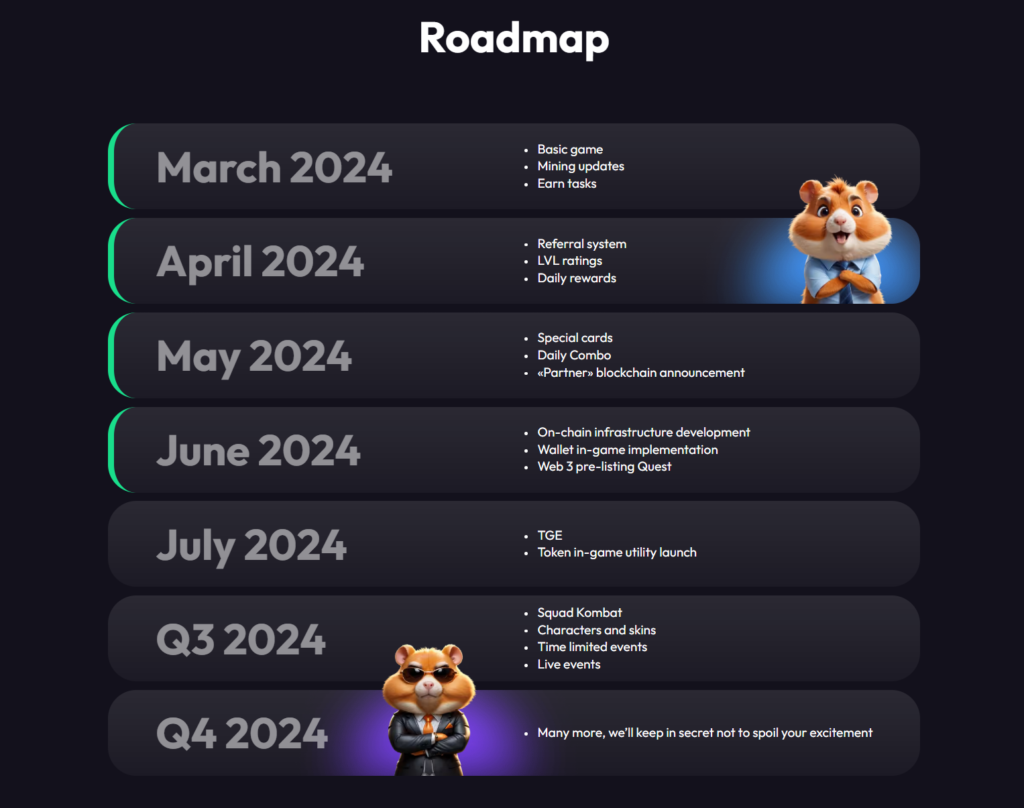
Game Sets Guinness Records and Boosts Engagement with New Levels
Hamster Kombat has set several Guinness World Records. The game’s YouTube channel has gained over 10 million subscribers in just six days, 13 hours, and 15 minutes. This milestone surpasses the growth rate of even Mr. Beast’s channel.
The game offers various ways for players to earn coins. One method involves watching YouTube content, where players earn 100,000 coins for each video viewed. This strategy has significantly boosted the game’s social media presence.

The developers have also introduced a new level for players’ hamster avatars. Reaching the “Creator” level requires accumulating 18 billion in-game coins. This has added another layer of engagement for the players.

Hamster Kombat’s success raises interesting questions about Web3 games. These games could potentially serve as an alternative universal basic income (UBI) mechanism. Players trade their time for in-game entertainment and education about cryptocurrencies.
Hamster Kombat’s approach to social media growth has resulted in staggering metrics. The game’s YouTube channel has 32 million subscribers since its launch in May 2024. Its X profile has 11.3 million followers, and its Telegram channel has 49.4 million subscribers.
Hot Projects
Binance Celebrates 7th Anniversary with 200 Million Users | EVM News


Key Takeaways:
- Binance Celebrates 7th Anniversary: Binance marks its seventh anniversary with over 200 million users worldwide.
- ‘Be Binance’ Campaign Launch: The campaign rewards customers with activities and contests across 19 countries.
- Educational Focus for Growth: Binance emphasizes education to reach the goal of one billion Web3 users.
YEREVAN (CoinChapter.com) — Binance, the world’s largest cryptocurrency exchange, is marking its seventh anniversary. The exchange now has over 200 million users worldwide, highlighting its significant presence in the digital asset industry.
Binance Celebrates 200 Million Users with Global ‘Be Binance’ Campaign
To commemorate this milestone, Binance has introduced a campaign called “Be Binance.” Rachel Conlan, Binance’s chief marketing officer, stated that the campaign aims to reward and celebrate the company’s loyal customers.
“Through determination, curiosity, and responsibility, we’ve faced challenges and reaped rewards, thanks to our 200 million users. As we journey toward financial freedom, we stay true to our values: humility, kindness, collaboration, and gratitude,”
Conlan said.
The “Be Binance” campaign includes activities such as in-person meet-ups, virtual events, and social media contests. The campaign will occur in 19 countries, including the United Arab Emirates, Australia, New Zealand, Bulgaria, Spain, and Benin. Participants can win a share of $7,000 worth of Binance’s BNB tokens and other merchandise.
Education Key to Binance’s Massive User Growth and Trading Volume
Binance sees substantial growth potential beyond its current user base. Rachel Conlan emphasized the importance of education in attracting more users.
“Education and raising awareness are absolutely key. 200 million+ is an impressive number, but both the industry and our user base still have massive potential for growth,”
she said.
Binance’s daily trading volume exceeds $25.3 billion, making it more than seven times larger than Coinbase, which has a daily trading volume of $3.3 billion. The exchange gained its first 100 million users in five years and reached 200 million in two more years. Over 30 million new users joined in the first half of 2024.
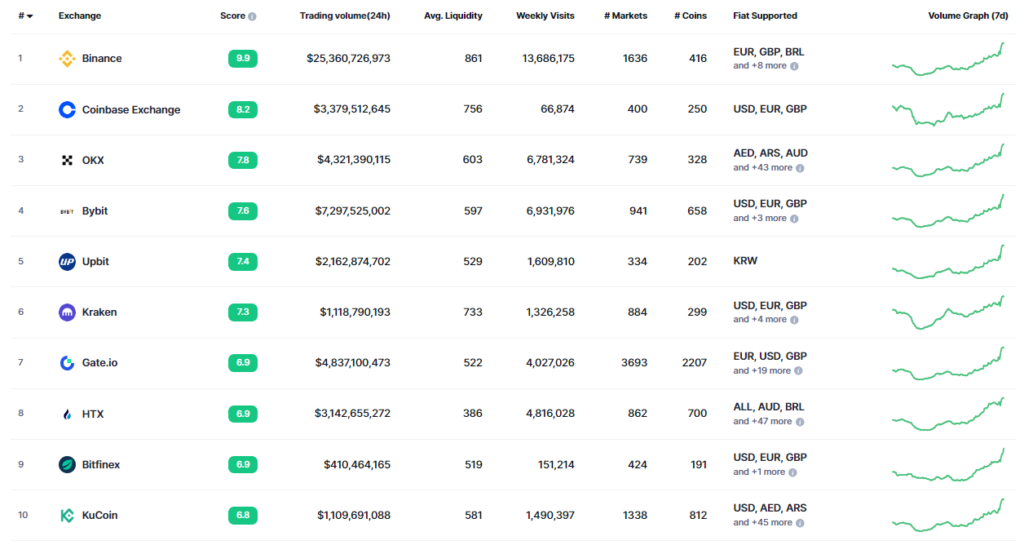
Binance Sets Sights on One Billion Web3 Users with ‘Be Binance’ Campaign
Binance aims to reach one billion Web3 users.
“A few years ago, 200 million users looked like something from a sci-fi movie. Today, onboarding the first billion to Web3 feels like an attainable target,”
Conlan said.
The “Be Binance” campaign is part of this effort, offering activities and educational initiatives.
Hot Projects
US Job Market Slump Could Fuel Bitcoin Prices | EVM News


YEREVAN (CoinChapter.com) — The US job market is showing signs of weakening, which might boost Bitcoin prices. The unemployment rate in the US rose to 4.1%, surpassing the anticipated 4.0%. This is the highest level since December 2021.
In June, the US economy added 206,000 jobs. This figure exceeded the expected 191,000 but fell short compared to May’s revised 218,000 jobs. The Bureau of Labor Statistics released this data on July 5.
A weakening labor market in the US could serve as a positive catalyst for Bitcoin prices. Jag Kooner, head of derivatives at Bitfinex, stated,
“If the NFP report shows weaker-than-expected job growth, it could increase expectations for future rate cuts, which might bolster Bitcoin prices as investors seek alternative assets in anticipation of a looser monetary policy.”
Bitcoin Price Trends Amid Job Market Changes
Bitcoin prices have been in a downtrend for over a month. The cryptocurrency has fallen below the significant $60,000 mark, reaching a four-month low. On July 5, Bitcoin dropped over 10.5% in 24 hours, hitting $53,550, according to Bitstamp data.
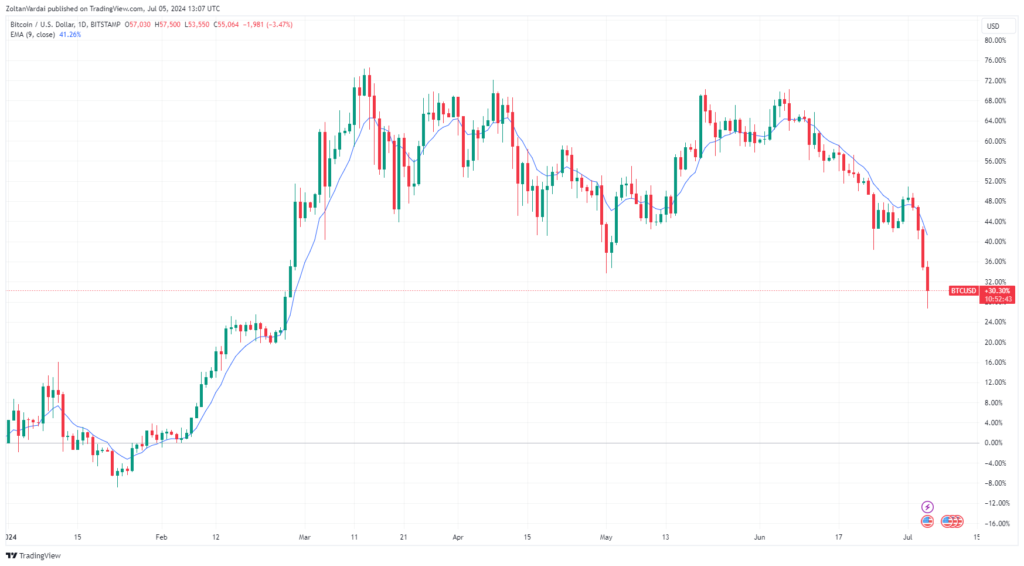
The last time Bitcoin traded at this level was in February 2024. Some traders worry the bull cycle might have ended, while others see the current correction as typical. The analyst Rekt Capital noted,
“This pullback is -21% deep & 45 days long. In this cycle, average retrace depth is -22% & average retrace duration is 42 days. In terms of retrace depth, this is almost an average retrace. In terms of retrace duration, this is an above-average pullback.”

Bitcoin ETFs Face Net Negative Outflows
Institutional inflows from US spot Bitcoin exchange-traded funds (ETFs) have been lagging. US ETFs are on track for their third consecutive week of net negative inflows. This week alone has seen over $315 million in cumulative net outflows, according to Dune data.
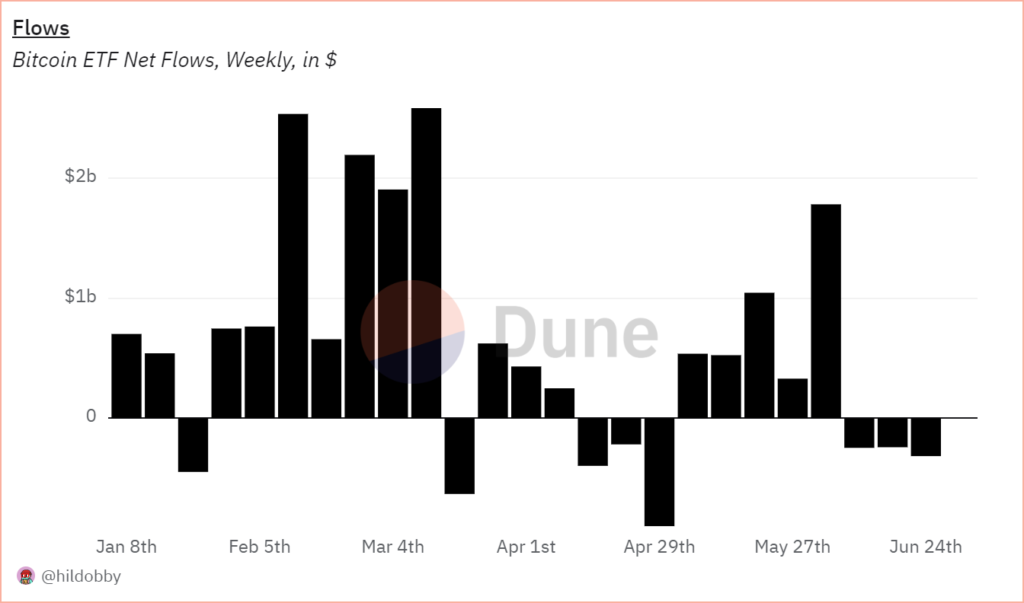
Kooner believes Bitcoin ETF flows could see an uptick if the weakening labor market drives expectations of an interest rate cut. He said,
“Bitcoin ETF flows might see an uptick if market participants believe that economic uncertainty will drive the Fed towards eventual rate cuts, enhancing the appeal of Bitcoin as an inflation hedge. However, significant inflows would depend on broader market sentiment and risk appetite.”
Summary of Key Points
- Unemployment Rate: Rose to 4.1%, highest since December 2021.
- Job Additions: 206,000 jobs added in June, lower than May’s revised 218,000.
- Bitcoin Prices: In downtrend, dropped to $53,550 on July 5.
- Bitcoin ETFs: Third week of net negative inflows, over $315 million outflows this week.
- Market Sentiment: Cautious with potential interest rate cuts being monitored.
-

 Latest News3 months ago
Latest News3 months agoCrypto New Media Decrypt Warns Against $Decrypt Token Airdrop Scam | EVM News
-

 Latest News4 months ago
Latest News4 months agoCeτi AI Announces Successful Launch Of Revolutionary Decentralized AI Infrastructure Token | EVM News
-
Hot Projects4 months ago
Fetch AI Outshines in AI Token Dominated Gainers but This New AI A… | EVM News
-

 Latest News4 months ago
Latest News4 months agoJapanese Telecom Companies Jump Into Crypto Sector, Plans To Launch Crypto Wallet | EVM News
-

 Latest News4 months ago
Latest News4 months agoBitcoin Dogs Sets A New Standard In Crypto Amidst Bitcoin Surge | EVM News
-
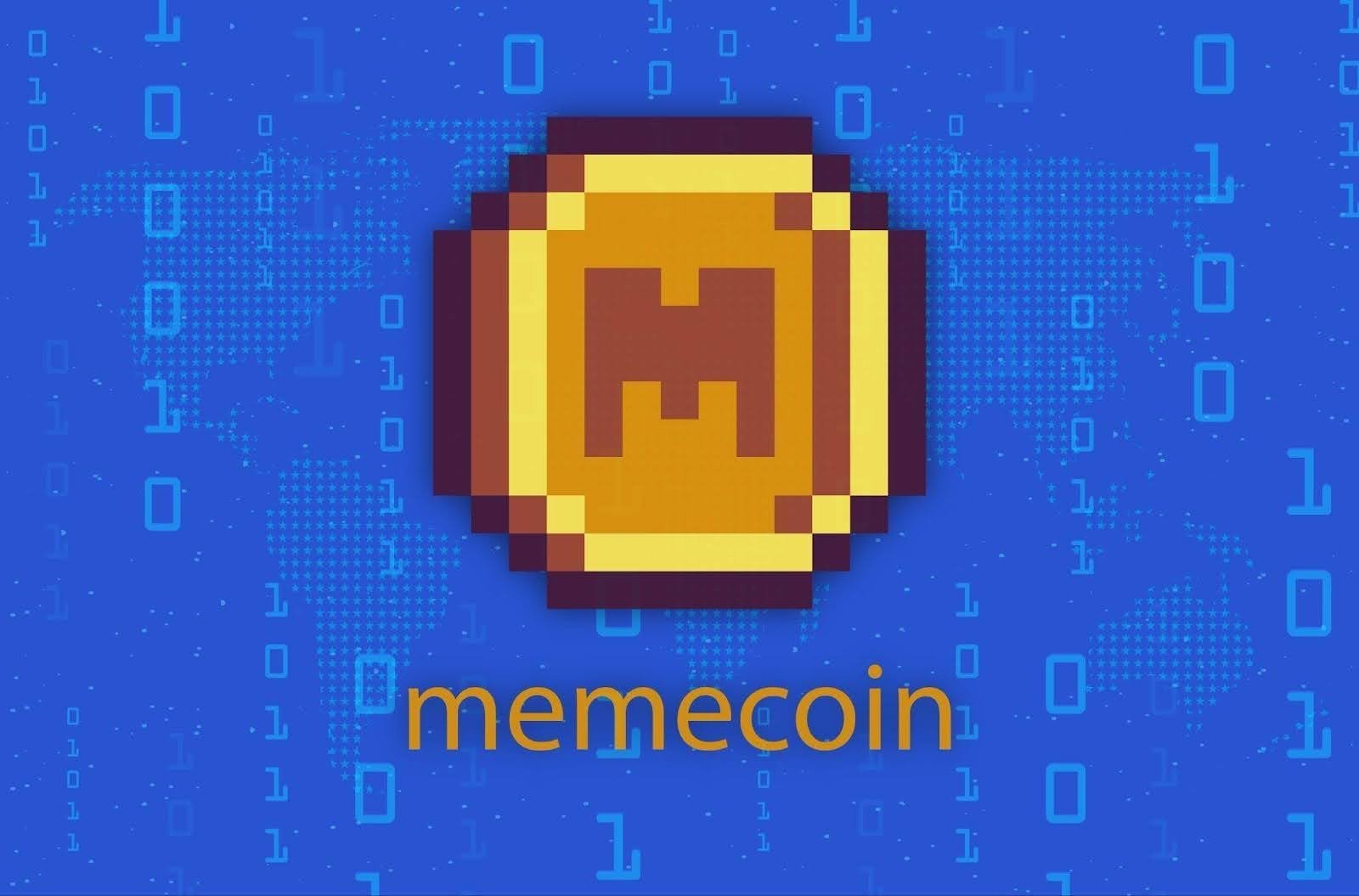
 Latest News2 months ago
Latest News2 months agoTelegram Founder Receives Donations In Notcoin Worth $7 Million, Rising Appeal For New Memecoin | EVM News
-

 Latest News3 months ago
Latest News3 months agoBC.GAME Secures New Curacao LOK License, Enhancing Legal Compliance And Global Reach | EVM News
-
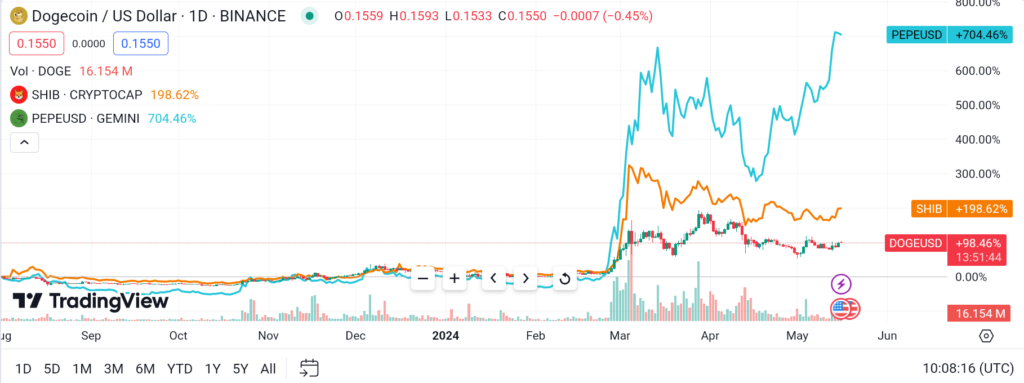
 Hot Projects2 months ago
Hot Projects2 months agoDogecoin is Severely Underperforming New Memecoins This Year — Sho… | EVM News


